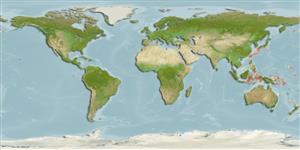Common names from other countries
>
Pleuronectiformes (Flatfishes) >
Bothidae (Lefteye flounders)
Etymology: Chascanopsetta: Greek, chaskanon, -ou = a mask used in classicla Greek theatre with the mouth opened + Greek, psetta = grouper (Ref. 45335).
Environment: milieu / climate zone / depth range / distribution range
นิเวศวิทยา
เกี่ยวกับทะเล,น้ำเค็ม สัตว์หน้าดินในเขตน้ำลึก; ระดับความลึก 320 - 375 m (Ref. 11412). Deep-water
Western Pacific: Kyushu-Palau Ridge. Reported from the Philippines (Amaoka, pers. comm.).
ขนาด / น้ำหนัก / Age
Maturity: Lm ? range ? - ? cm
Max length : 27.4 cm SL เพศผู้/กระเทย; (Ref. 11412)
Life cycle and mating behavior
Maturities | การสืบพันธุ์ | Spawnings | Egg(s) | Fecundities | ตัวอ่อน
Amaoka, K. and E. Yamamoto, 1984. Review of the genus Chascanopsetta, with the description of a new species. Bull. Fac. Fish. Hokkaido Univ. 35(4):201-224. (Ref. 11412)
IUCN Red List Status (Ref. 130435)
CITES (Ref. 128078)
Not Evaluated
Threat to humans
Harmless
Human uses
เครื่องมือ
Special reports
Download XML
แหล่งที่มาจากอินเตอร์เน็ต
Estimates based on models
Preferred temperature (Ref.
115969): 11.2 - 16, mean 15.3 (based on 451 cells).
Phylogenetic diversity index (Ref.
82804): PD
50 = 0.5039 [Uniqueness, from 0.5 = low to 2.0 = high].
Bayesian length-weight: a=0.01000 (0.00244 - 0.04107), b=3.04 (2.81 - 3.27), in cm Total Length, based on all LWR estimates for this body shape (Ref.
93245).
ระดับชั้นอาหาร (Ref.
69278): 3.7 ±0.4 se; based on size and trophs of closest relatives
ความสามารถในการกลับคืนสู่ปกติ (Ref.
120179): ต่ำ, เวลาต่ำสุดที่จะทำให้ประชากรเพิ่มขึ้นเป็น 2 เท่าใช้เวลา 4.5 - 14 ปี (Preliminary K or Fecundity.).
Fishing Vulnerability (Ref.
59153): Low vulnerability (23 of 100).
